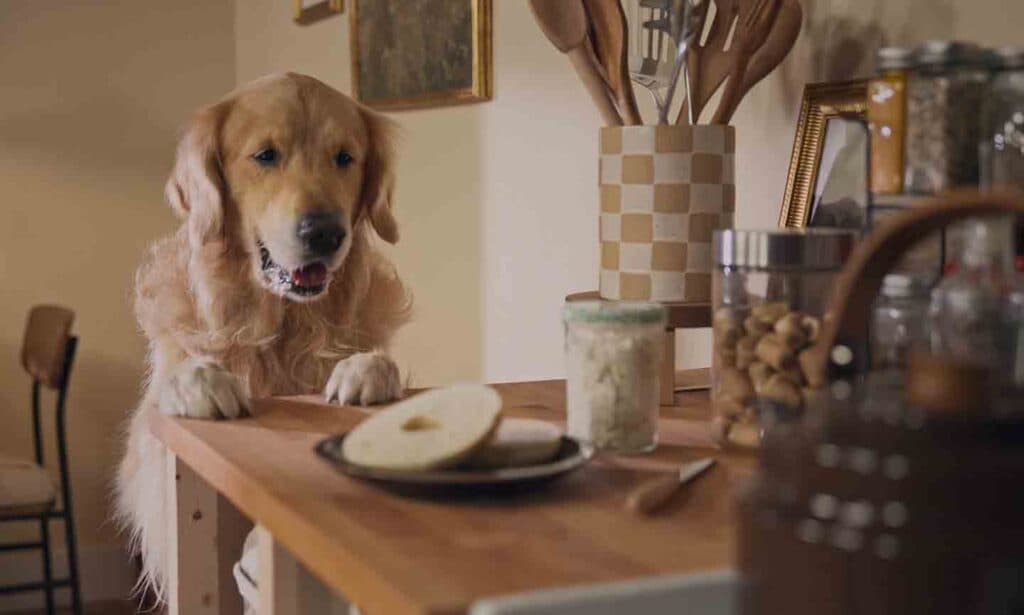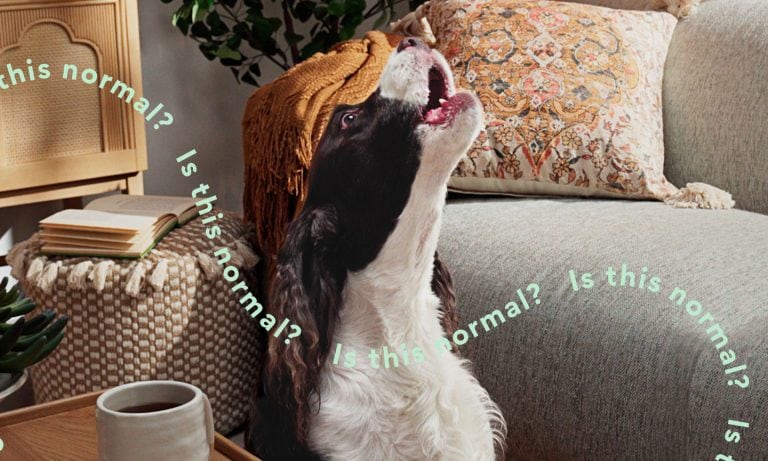Our pups have all the audacity. The audacity to look that cute when they tilt their head to the side with deep inquisition, the audacity to steal our hearts and capture our love hook, line and sinker—and the audacity to help themselves to the kitchen counter or coffee table to see what’s ripe for the taking.
If you’ve got a counter-surfing dog, there’s no doubt you’ve experienced some frustration around this unwanted behavior. After all, your goal is to keep your pup safe and ensure your belongings stay in good shape too. Ahead, we’re covering why dogs jump onto countertops and how to stop counter surfing once and for all.
Why Do Dogs Jump on Counters?
So what’s up with a dog’s deep desire to counter surf? Is it just that they’re hungry and looking for a snack to chomp on? Or are they merely curious about what’s out of sight when on all fours?
All About That Food
Interesting smells (including food) tend to be the biggest motivator for why a dog jumps onto counters.
“The biggest reason so many dogs are drawn to our counters is because they associate it with food,” says Amanda Farah, national training and behavior coordinator for Best Friends Animal Society, based in Kanab, Utah. “Whether it just smells like whatever we prepped for dinner or we forgot to put the bread away, their noses know.”
Dogs evolved as opportunistic feeders, often scavenging for food near humans. It’s ingrained dog behavior for them to scavenge food prep areas for deliciously tempting morsels.
It’s a Fun Game, Too
Farah also notes that counter surfing becomes a learned behavior over time.
“You may have experienced this scenario yourself,” she says. “The dog goes scavenging. He jumps up on the counter and grabs something delicious—say, a bag of chips. You immediately snap into action, calling the dog, chasing when he doesn’t respond, maybe trying to trade him for a toy. You eventually catch up to him and take the chips but not before he ate a couple. What an exciting game!”
The next time the dog wants your attention, he might just try it again. There’s no food this time—you’ve wisened up—but maybe his ploy will still work if he gets a hold of something else. Will you play the fun game to get your glasses back? There’s a good chance you will. The fun continues for the dog while the frustration deepens on your end.
How To Keep Dogs off Countertops
Sure, a piece of toast gone missing isn’t the end of the world, but dogs can potentially get themselves into trouble when scavenging counters and tables. They could get a hold of a toxic item—like a plant, food-scented candle or off-limits food—or grab a dangerous object like a knife or a cup full of hot water.
For all these reasons, it’s important for dog parents to curb this bad habit. Follow these dog training tips to prevent your pup from counter surfing.
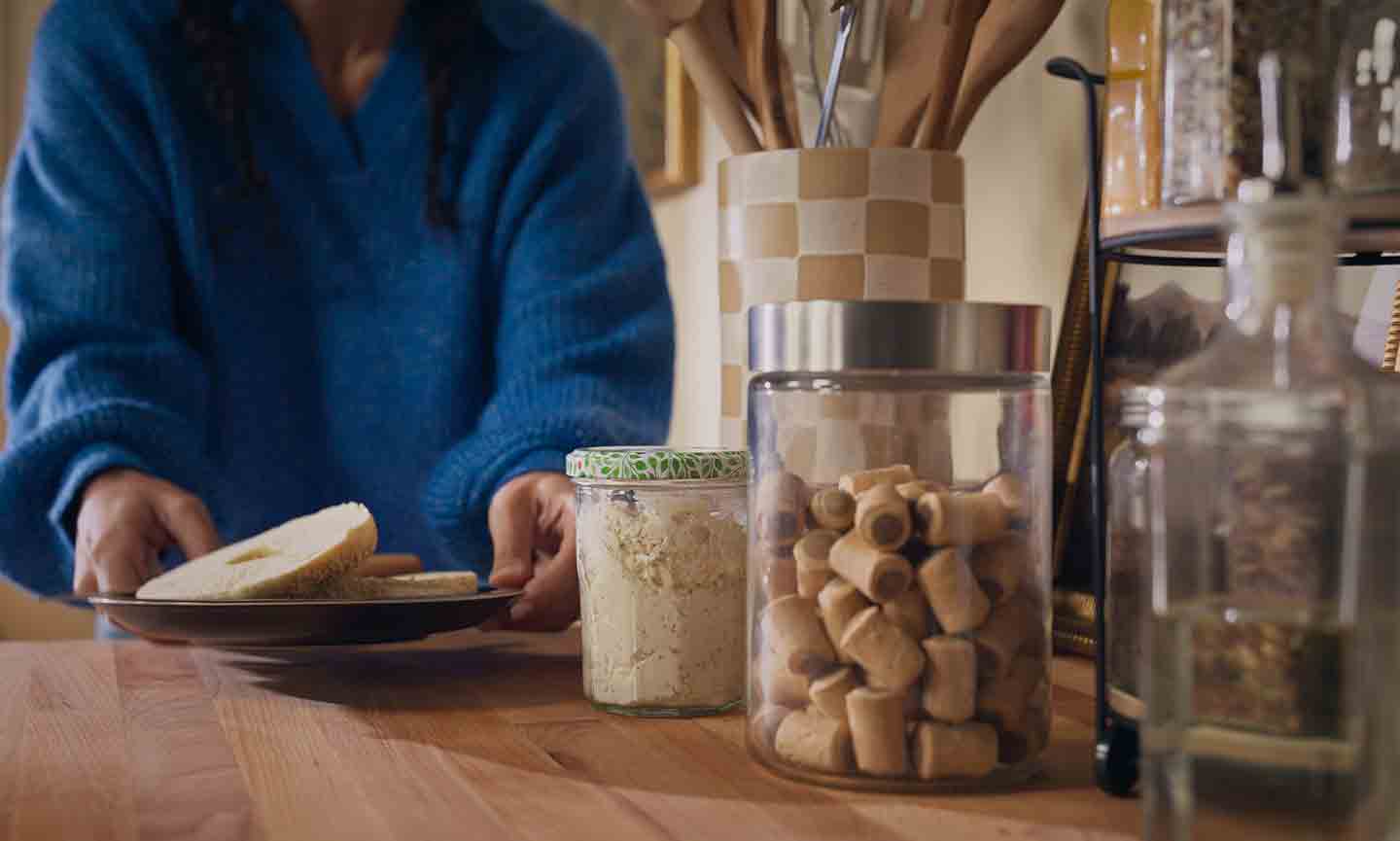
1Keep Food off Your Counters
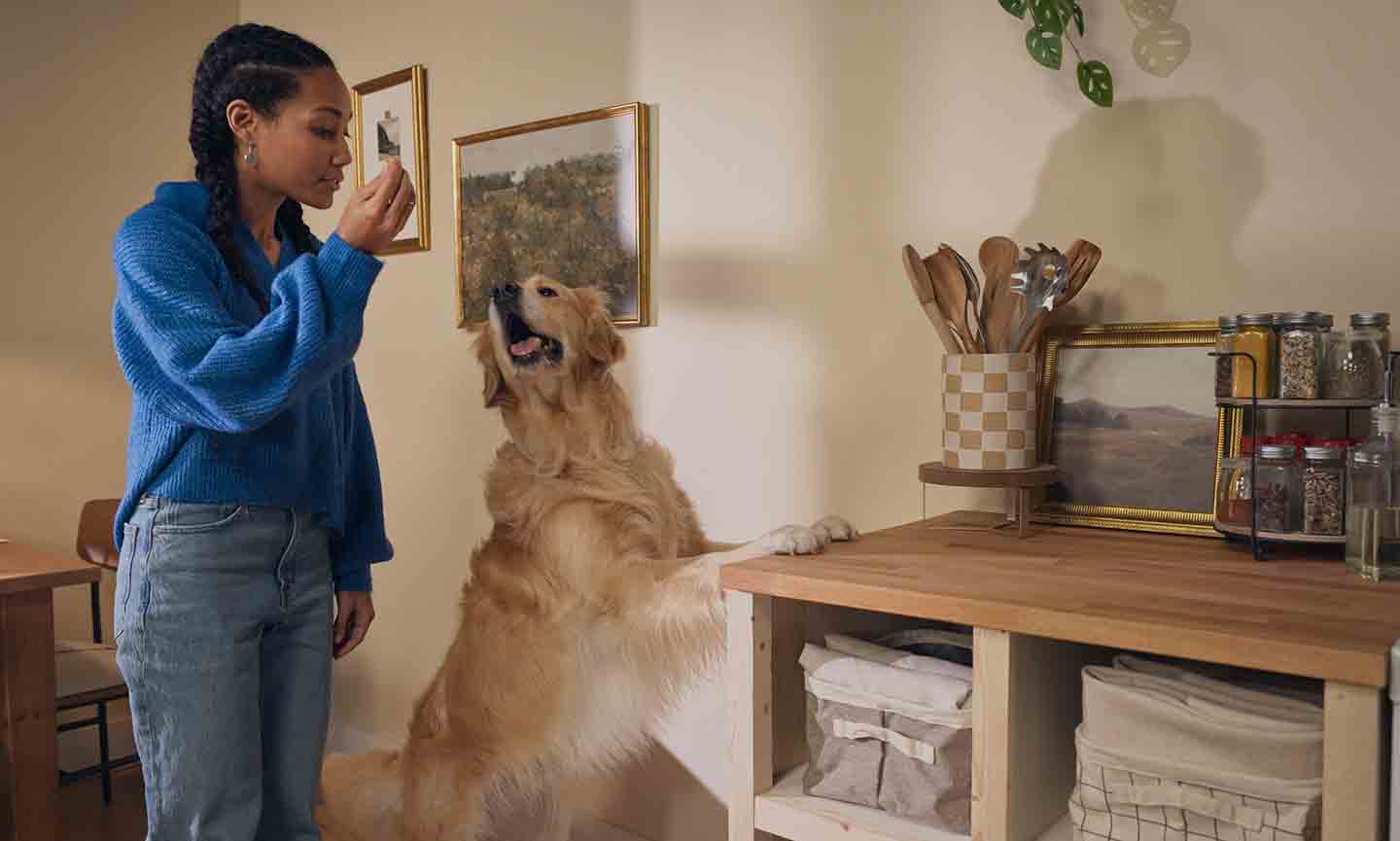
2Teach Your Dog the “Off” Cue
Basic obedience training for dogs includes teaching them the “off” cue, which helps curb unwanted behavior such as jumping on people or poking around countertops. “With the ‘off’ cue, our dog is rewarded for four feet on the ground and not when jumping up or counter surfing,” says Joy.
Follow our guide on teaching your dog the “off” command.
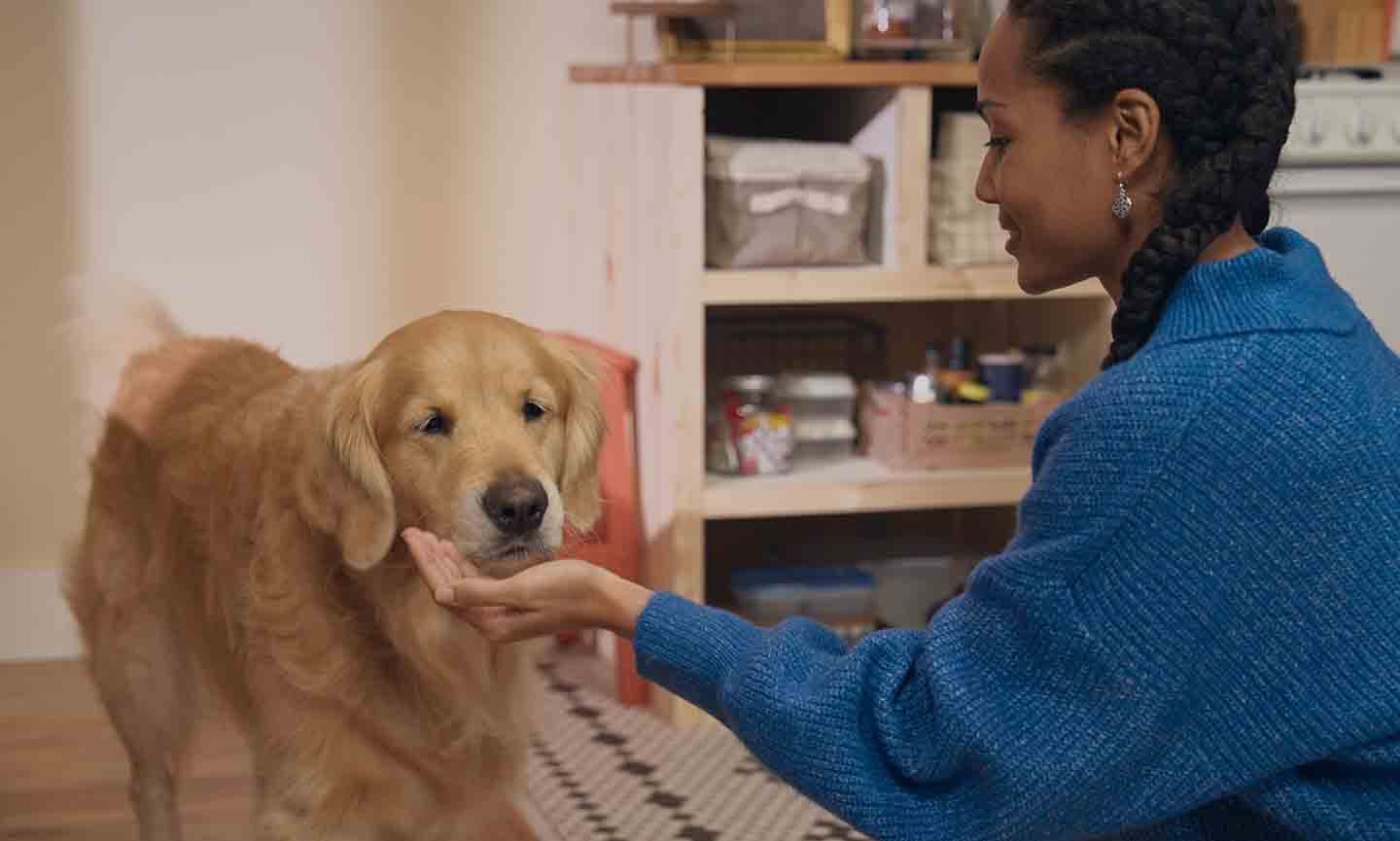
3Use Positive Reinforcement
Provide positive reinforcement when they obey cues by giving them a dog treat, giving them head scratches and cuddles, and excitedly praising them. When your dog associates these wonderful things with listening to you, their recall becomes stronger and stronger over time. We like Zuke’s Mini Naturals Peanut Butter & Oats Recipe Training Dog Treats and Blue Buffalo Blue Bits Tasty Chicken Recipe Soft-Moist Training Dog Treats.
You can also utilize deterrents that make your countertops a less desirable area to roam, such as:
- Applying a sour-tasting spray, like NaturVet Bitter YUCK! No Chew Spray, to the counter
- Placing aluminum foil around the edges of your counter (some dogs don’t like the feel of it)
- Placing sticky tape along the edges of your counter (sticky-side up). You can try something like Emmy's Best Pet Products Stop The Scratch Furniture Protector Tape, which is transparent, can be cut to size, and is non-toxic and residue-free. Sticky tape is often used to deter cats, but many dogs don’t like the sticky sensation on their paws, either.

4Remove Items That Make Access Easier
Larger dogs can often reach countertops just by standing on their hind legs. But smaller dogs typically need a boost, whether it’s from nearby furniture, shelves or other items they can use as a stepping stool. In addition to following all of the above steps to deter this undesirable behavior, it’s also helpful to remove anything that makes getting onto the countertops easier.
If you’re dealing with a dog who is persistent in their counter-surfing behavior, consider keeping them in a kennel or crate when you’re out of the home or not able to watch them closely to ensure they don’t get into trouble while you’re away. Remember to follow these guidelines for crating your dog:
- No dog should be crated for more than 4 hours
- For puppies, that limit is even shorter: About an hour for every month of age, so a 3-month-old puppy shouldn’t be left in a crate for longer than 3 hours.
Counter Surfing Dog Breeds
While any dog can technically become a counter-surfer, some breeds may be more prone to this. This includes breeds that are excellent hunters (like hounds) and larger breeds that simply have the physical capacity to do so. (You’re not likely to see teeny pups hopping on counters, at least not without a little help.)
Here are some breeds that are notorious for their counter surfing habits:
- Labrador Retrievers
- Boxers
- Hounds, such as Greyhounds, Basset Hounds, foxhounds and wolfhounds
- Poodles
- Beagles
- Great Danes
- Shiba Inus
Need more help teaching your pup to stay away from the counter? Consider finding a certified professional dog trainer who can help you troubleshoot based on your pup's unique personality and behaviors.
From the moment you bring home your new puppy or dog, it’s important to instill good habits. Teaching them basic cues—like “off,” “sit,” “stay” and “place”—is a great place to start. Setting them up for success by removing tempting items from your countertops and supplying them with toys is also wise. It may take them time to get the hang of things, but with patience and positive reinforcement they’ll get the hang of it.
Expert input for this story provided by Chrissy Joy, professional dog trainer at BFF Pet Services in St. Mary’s County, Maryland; Amanda Farah, a national dog training expert and behavior coordinator for Best Friends Animal Society, based in Kanab, Utah.
Can My Dog Eat That?
Share:
